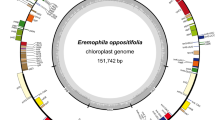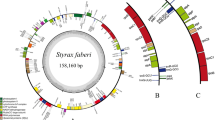Abstract
The subtype PIII plastids found in 16 additional species ofCaryophyllales investigated here corroborate the homogeneity of this order with respect to the sieve-element plastids. While two new examples (Glinus, Allmania) which exhibit the rare presence of starch grains in the PIII-plastids are found, the restriction of the three forms of PIII-plastids to distinct taxa is maintained: PIIIf inChenopodiineae; PIII c′f inCaryophyllaceae (3 species added),Stegnospermataceae andAchatocarpaceae; PIII cf in all other families (among the 11 species investigated 5 fromMolluginaceae).
Similar content being viewed by others
References
Behnke, H.-D., 1976a: Die Siebelement-Plastiden derCaryophyllaceae, eine weitere spezifische Form der P-Typ-Plastiden bei Centrospermen. — Bot. Jahrb. Syst.95, 327–333.
Behnke, H.-D., 1976b: Ultrastructure of sieve-element plastids inCaryophyllales (Centrospermae), evidence for the delimitation and classification of the order. — Pl. Syst. Evol.126, 31–54.
, 1978: Elektronenoptische Untersuchungen am Phloem sukkulenter Centrospermen (incl.Didiereaceen). — Bot. Jahrb. Syst.99, 341–352.
, 1981: Sieve-element characters. — Nordic J. Bot.1, 381–400.
, 1982a: Sieve-element plastids, exine sculpturing and the systematic affinities of theBuxaceae. — Pl. Syst. Evol.139, 257–266.
, 1982b:Geocarpon minimum: Sieve-element plastids as additional evidence for its inclusion in the Caryophyllaceae. — Taxon31, 45–47.
-Mabry, T. J., Neuman, P., Barthlott, W., 1983: Ultrastructural, micromorphological and phytochemical evidence for a “central position” ofMacarthuria (Molluginaceae) within theCaryophyllales. — Pl. Syst. Evol.143 (in press).
Cronquist, A., 1981: An Integrated System of Classification of Flowering Plants. — New York: Columbia Univ. Press.
Dahlgren, R. M. T., 1980: A revised system of classification of the angiosperms. — Bot. J. Linn. Soc.80, 91–124.
Ehrendorfer, F., 1976: Closing remarks: Systematics and evolution of Centrospermous families. — Pl. Syst. Evol.126, 99–105.
Hofmann, U., 1973: Morphologische Untersuchungen zur Umgrenzung und Gliederung der Aizoaceen. — Bot. Jahrb. Syst.93, 247–324.
Mabry, T. J., 1976: Pigment dichotomy and DNA-RNA hybridization data for Centrospermous families. — Pl. Syst. Evol.126, 79–94.
, 1976: Betalains and P-type sieve-element plastids inGisekia L. (Centrospermae). — Taxon25, 112–114.
Takhtajan, A., 1980: Outline of the classification of flowering plants (Magnoliophyta). — Bot. Rev.46, 225–359.
Author information
Authors and Affiliations
Rights and permissions
About this article
Cite this article
Behnke, H.D., Pop, L. & Sivarajan, V.V. Sieve-element plastids ofCaryophyllales: Additional investigations with special reference to theCaryophyllaceae andMolluginaceae . Pl Syst Evol 142, 109–115 (1983). https://doi.org/10.1007/BF00989606
Received:
Issue Date:
DOI: https://doi.org/10.1007/BF00989606




